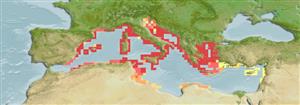分類 / Names
俗名 | 同種異名 | Catalog of Fishes (gen., sp.) | ITIS | CoL | WoRMS | Cloffa
Actinopterygii
輻鰭魚綱 (條鰭魚) >
Perciformes (Perch-likes) >
Blenniidae (Combtooth blennies) > Salariinae
Etymology: Salaria: Latin, salar, salaris = trout (Ref. 45335).
環境 / 氣候 / 範圍
生態學
; 海洋; 淡水; 半鹹淡水 居於水底的; pH range: 6.5 - 7.5; dH range: 8 - 12. 18°C - 24°C (Ref. 13371), preferred ?; 47°N - 32°N, 7°W - 37°E
Europe and Africa: Africa: Rivers and brooks in Algeria and Morocco flowing to the Mediterranean; including Israel. Europe: Albania, Croatia, France, Greece, Italy, Montenegro and Spain (Ref. 26100); Portugal (Ref. 13612). Asia: Turkey.
大小 / 重量 / 年齡
Maturity: Lm ? range ? - ? cm
Max length : 15.4 cm TL 雄魚/尚未辨別雌雄; (Ref. 95757); common length : 8.0 cm TL 雄魚/尚未辨別雌雄; (Ref. 556)
背棘 (總數): 12 - 13; 背的軟條 (總數): 16-17; 臀棘 2; 臀鰭軟條: 16 - 19; 脊椎骨: 36. This species is distinguished from its congeners in European inland waters by the following combination of characters: a broad diagonal band of tiny dots running from eye backward and downward; branched cirrus above eye; head length 25-31% SL; upper jaw with 16-24 teeth, lower jaw with 16-20; A II,16-19; D XII-XIII,16-17 (Ref. 59043).
Adults occur in rivers and brooks (Ref. 4342), in relatively shallow water as well as in low altitude lakes (Ref. 30578), on stone bottom; in streams, deepest and fastest microhabitats are preferred and sometimes coastal lagoons with low salinity (Ref. 59043). A territorial species that lives up to 5 years (Ref. 59043). Adults feed on small benthic organisms, aquatic insects and pupae (Ref. 94105). Oviparous (Ref. 205). Females spawn for the first time at the end of the first year and spawning lasts up to 3 years but with most females dying at the end of the first spawning year. One female spawns up to 1,200 eggs (usually 200-300) in a single layer under a large stone; spawns several egg portions during the season. On the other hand, the males clean, fan and defend the eggs until hatching. Several females may spawn with one male, which may guard the eggs at different stages of development (Ref. 59043). Eggs are demersal and adhesive; eggs hatch in about a week (Ref. 205, 59043). Planktonic larvae until about 1.5 cm, are drifted to and remain in quiet pools or side arms of rivers (Ref. 59043). Populations are threatened due to pollution and water abstraction (Ref. 26100); most riverine populations affected by habitat alteration (especially siltation and alteration of stream morphology), and predation of exotic species. Presence of habitat suitable for the pelagic 'larval' stage downstream of spawning sites is a limiting factor; lacustrine population are apparently safer (Ref. 59043).
Life cycle and mating behavior
成熟度 | 繁殖 | 產卵場 | 卵 | 孕卵數 | 仔魚
Produces 200-300 eggs (Ref. 1672). Paternal care (Ref. 4342). Male cleans, fans and defends eggs until hatching. Several females spawn with one male, which may guard eggs at different stages of development. Eggs hatch in about a week (Ref.59043).
Bath, H., 1986. Blenniidae. p. 355-357. In J. Daget, J.-P. Gosse and D.F.E. Thys van den Audenaerde (eds.) Check-list of the freshwater fishes of Africa (CLOFFA). ISNB, Brussels, MRAC, Tervuren; and ORSTOM, Paris. Vol. 2. (Ref. 4342)
CITES (Ref. 94142)
Not Evaluated
人類使用
漁業: 沒有興趣; 水族館: 商業性
更多資訊
參考文獻養殖養殖資訊品種遺傳學基因序列遺傳率疾病加工Mass conversion
合作者照片Stamps, Coins聲音神經毒速度泳型鰓區Otoliths腦重體重比眼睛色素
工具
特別的報告
下載 XML
網路資源
